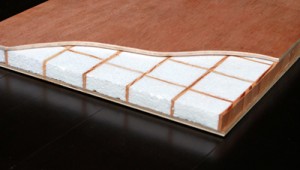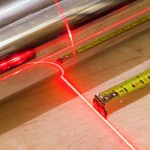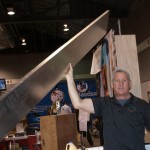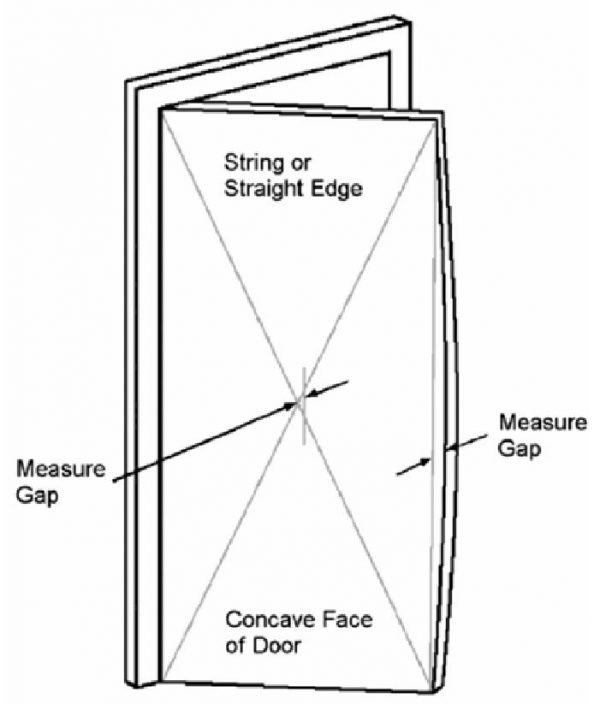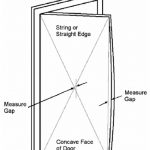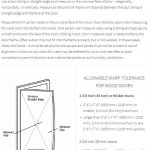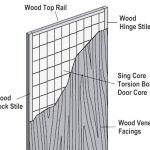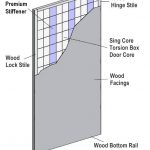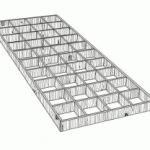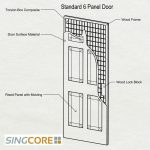The mystery of door warping:
Ever since people started making doors, especially large doors, they have had to deal with the problem of warping. Door designers and manufactures are still dealing with this scary problem. The problem is so widespread that if customers were more demanding, they would not settle for the AWI standards for warping. Door warp makes doors bend and creates air leaks. If you look at the many frustrated discussions on the Internet about how to deal with door warping, you never see a discussion about the “core” of the problem. Yet, how can you solve the problem if you do not address the cause?
What is the cause?
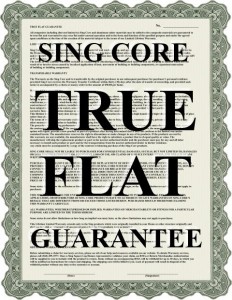 1. The standard door core is a main cause. No matter what kind of standard core a door is made from, whether paper core, foam core, SLC (Stave lumber core), particleboard, SCLS (Structure composite lumber), LVL (Laminated veneer), mineral core, mdf, cardboard, etc., etc., etc., warping is inevitable. Even a solid wood door will warp. A sliding or pivot door will have unbearable warp at only ¼ inch due to the reference next to a straight wall or door jam. This warping is even worse in a door over 8 feet because of the strength of the movement. So far, the best solutions have been to only make 7-foot high doors, or to make excuses (i.e., no or very limited warrantees) for doors over 8 feet, or to use gaskets to hide the minor warping, but these are temporary solutions that require costly maintenance and replacement and tarnish the reputations of the building trade professionals involved in the projects. As such, most doors usually do not have warranty protection against the inevitable warping. Even with SCLC (Structure composite lumber core) and LVL (Laminated veneer), commonly used in high end large door will not remain true flat due to the wood fiber constantly moving.
1. The standard door core is a main cause. No matter what kind of standard core a door is made from, whether paper core, foam core, SLC (Stave lumber core), particleboard, SCLS (Structure composite lumber), LVL (Laminated veneer), mineral core, mdf, cardboard, etc., etc., etc., warping is inevitable. Even a solid wood door will warp. A sliding or pivot door will have unbearable warp at only ¼ inch due to the reference next to a straight wall or door jam. This warping is even worse in a door over 8 feet because of the strength of the movement. So far, the best solutions have been to only make 7-foot high doors, or to make excuses (i.e., no or very limited warrantees) for doors over 8 feet, or to use gaskets to hide the minor warping, but these are temporary solutions that require costly maintenance and replacement and tarnish the reputations of the building trade professionals involved in the projects. As such, most doors usually do not have warranty protection against the inevitable warping. Even with SCLC (Structure composite lumber core) and LVL (Laminated veneer), commonly used in high end large door will not remain true flat due to the wood fiber constantly moving.
2. The skin is a cause because of moisture and/or temperature imbalance on the inside and the outside of a door. For example, an exterior door is up against different climates on both sides of the door and in the interior of the door. This difference in moisture and temperature inside and outside the door moves or warps the surfaces. For example, if one side of a door is up against 12 percent moisture and the other side of the door 7 percent, then the low-moisture side will pull the higher-moisture side of the door to cause warping. Eventually, this constant warping action causes permanent damage and allows drafts and leaks through the door.
3. The inadequate glue between the skin and the core is a cause. Warping also causes surface material (“skin”) such as fiberglass to delaminate between the foam and fiber glass skin, or the door core made of paper or cardboard, or light density foam. Doors usually start out perfectly flat, but eventually impact and weathering separates the door core from the skin, and the door is warped.
4. Weight is a cause. Some door skin, such as lead, cement, minal board, etc., is so heavy that it causes the door to collapse, sometimes even during the moving and installation process.
Yet, the warping problem has been solved! Building designers, contractors and millworkers as well as homeowners can dance for joy.
The revolutionary patented Sing core technology has solved the warping nightmare. Doors made with Sing panels are true flat (non-warping) and will stay true flat and can be guaranteed true flat for 50 years. It is like Sing panels have true-flat memory! The Sing panel core is a honeycomb/torsion box foam grid wherein the wood grain is perpendicular to the skin and held together with our patented formaldehyde-free glue. So, our patented Sing cores are 90 percent air, which does not move, supported by the strongest structure possible. As such,
Sing panels are:
1. Dimensionally stable with a high precision Sing core tolerance of +/- .006 inch. This is laser precision which produces the smoothest and most true-flat panels.
2. Fully insulated in the protection of our patented Sing grid structure for temperature control and sound-deadening qualities. Sing cores are 3 to 5 times more insulated than solid wood-based door cores. Note: Our patented Sing core structure prevents separation of the foam and the skin which preserves the original strength and insulation value.
3. Lightweight so that even a 4 inch thick door will weigh only 2 to 3 pounds per square foot. An average wood-core weighs 8 to 10 times more than our patented Sing core.
4. High strength which has been verified by the University of Washington at above 660 PSI, making our Sing panels pound-for-pound stronger than steel. (You could drive a 12,000-pound forklift with heavy rubber wheels over them without crushing them!)
5. Water-resistance/waterproof doors made of patented Sing core panels can be completely exposed to the weather without warping. (Click here to see our exterior door gallery.)
6. Eco-friendly and non-toxic structure glue for bonding skins and Sing core.
In summary, patented Sing core not only solves the door-warp problem, but also keeps the finished product high precision true flat, lightweight and high strength, plus provides great insulation and sound reduction and is eco-friendly.
Door Warp
Door warp is a variation from a plane surface within the door itself. It does not refer to the door in relation to the frame or jamb in which it was hung. Bow, cup, and twist are terms which describe warp in a door and are defined as follows: Bow is a curvature along the door height, or a deviation from a flat plane from end to end. Cup is a curvature across the door width or a deviation from a flat plane from side to side. Twist is a distortion in which one corner is out of the plane of the other three corners. Warp is usually a result of unequal stresses within the door from one face to the other caused by changes in humidity and temperature conditions or uneven conditions from one face to the other. Buildings shall be humidity and temperature controlled before doors are delivered and installed. Required conditions are 25% to 55% relative humidity and 50° to 90° F (10° to 32° C) temperature range. Improper handling, stacking, and storage can also contribute to warp. Doors shall be stored flat on a level surface off the floor with cross supports.
Warp-free definition: Doors with patented professional SingCore inside outperform any other Eco-friendly door in the world in terms of being lightweight (SingCore weight is approximately 10 % of solid wood, timber or plywood core) and high strength (660 PSI+, stronger than steel pound-for-pound). No other door Eco-friendly door made in the USA can reach our high precision (SingCore approximately +/- .006 inch) or flatness (far exceeding door industry allowance for door warp, as seen above). We guarantee no other Eco-friendly, lightweight, high-strength insulated door can compare with any door that has patented professional Sing Core inside. SingCore is raising the standard of what is possible in terms of building large doors that can be true flat and warp-free.

